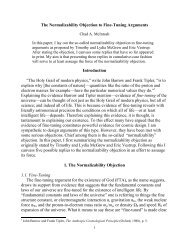Theism and Explanation - Appeared-to-Blogly
Theism and Explanation - Appeared-to-Blogly
Theism and Explanation - Appeared-to-Blogly
Create successful ePaper yourself
Turn your PDF publications into a flip-book with our unique Google optimized e-Paper software.
Successful Theistic <strong>Explanation</strong>s 127<br />
before the portable dark sucker can operate again. If you break open<br />
one of these fi lled canisters, one will see that there is indeed a great<br />
quantity of s<strong>to</strong>red dark on the inside. 36<br />
And so on. Intriguingly, this account of an outrageous proposed explanation—let’s<br />
call it “Dark Sucker Theory” (DST) 37 —also includes facts that,<br />
at fi rst sight, might appear <strong>to</strong> corroborate it. There are, of course, many<br />
facts that count against it. But one of these is that DST is so radically at<br />
variance with what we already know about the world. 38 This is already suffi<br />
cient reason not <strong>to</strong> take it seriously.<br />
“But DST,” you might respond, “is nothing more than an internet joke.”<br />
And that is true. So let me illustrate the importance of background knowledge<br />
with a well-known, real-life example. 39 When Darwin set out his theory<br />
of biological evolution, a major diffi culty facing his theory was that we could<br />
not directly observe the process of natural selection. So a key question was:<br />
Do we know of any mechanism of this kind <strong>to</strong> which we can appeal, which<br />
would give natural selection the status of a vera causa, a “true cause”? 40<br />
Darwin found such a mechanism in artifi cial selection, the process by which<br />
plant <strong>and</strong> animal breeders select favourable characteristics. 41 As it happens,<br />
Darwin was disappointed <strong>to</strong> see his theory rejected by the chief exponent of<br />
the vera causa doctrine, John Herschel. 42 But the point is that Darwin felt<br />
it was important <strong>to</strong> point <strong>to</strong> some mechanism, with which we were already<br />
familiar, which was analogous <strong>to</strong> the one he was positing.<br />
To say we should prefer theories that are consistent with what we already<br />
know is not <strong>to</strong> embrace the view that explanation consists of “reduction<br />
<strong>to</strong> the familiar.” 43 After all, much recent scientifi c explanation has been<br />
what we might call reduction <strong>to</strong> the unfamiliar, the principles <strong>and</strong> entities<br />
posited by both relativity theory <strong>and</strong> quantum physics being very strange<br />
indeed. 44 Rather, what I am advocating is the view that<br />
other things being equal, the explanations afforded by a theory are better<br />
explanations if the theory is familiar, that is, introduces mechanisms,<br />
entities, or concepts that are used in established explanations. The use<br />
of familiar models is not essential <strong>to</strong> explanation, but it helps. 45<br />
And if we must depart from what is familiar, we are safest <strong>to</strong> do so by way<br />
of a series of conservative steps, rather than by taking a gr<strong>and</strong> leap in<strong>to</strong> the<br />
dark. For as Quine <strong>and</strong> Ullian remark, “the longer the leap . . . the more<br />
serious an angular error in the direction.” 46<br />
7.2.1 <strong>Theism</strong> <strong>and</strong> Background Knowledge<br />
How would a theistic hypothesis rate, when assessed against this desideratum?<br />
The problem here is that the theistic hypothesis posits a mechanism—<br />
the action of a spiritual being within the material world—that is entirely<br />
unlike any other mechanism with which we are familiar. Not only does



